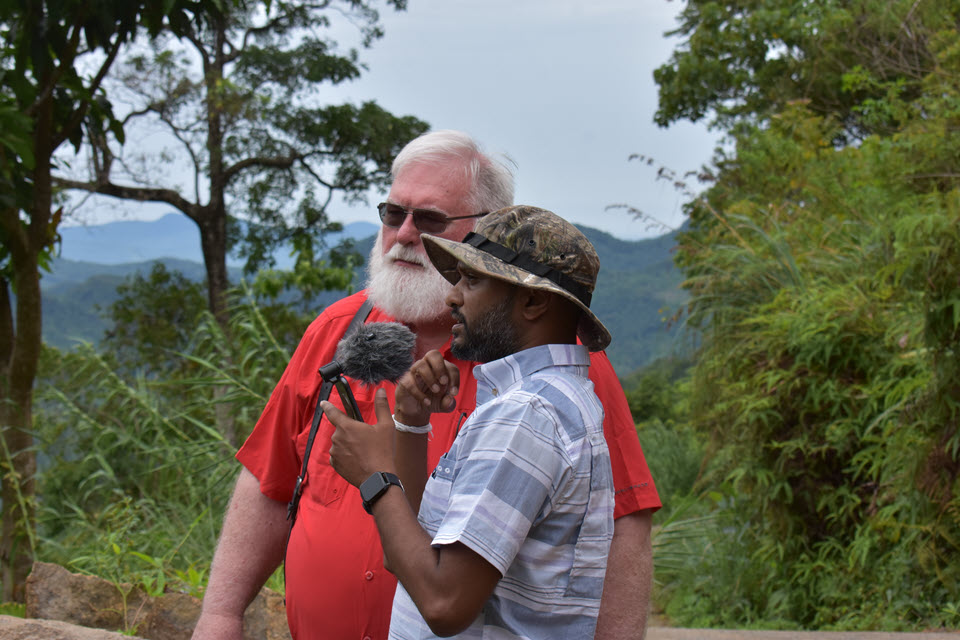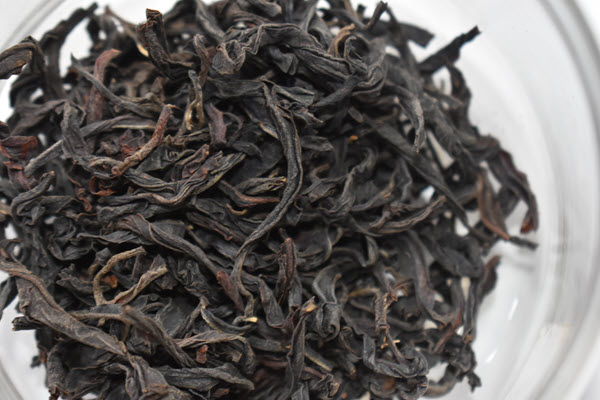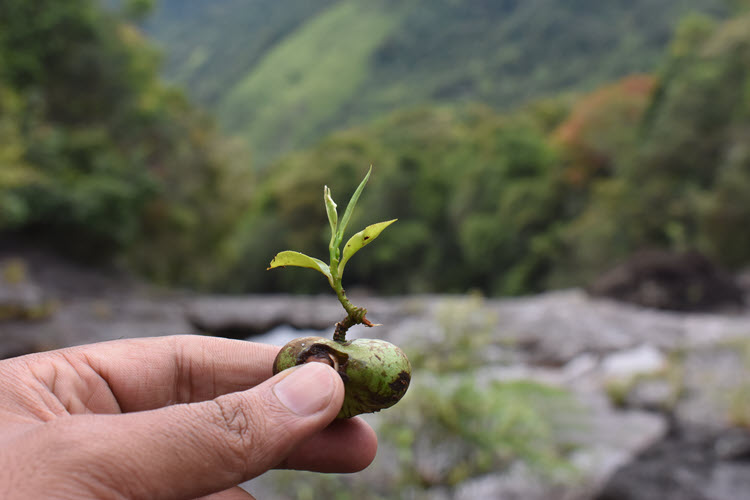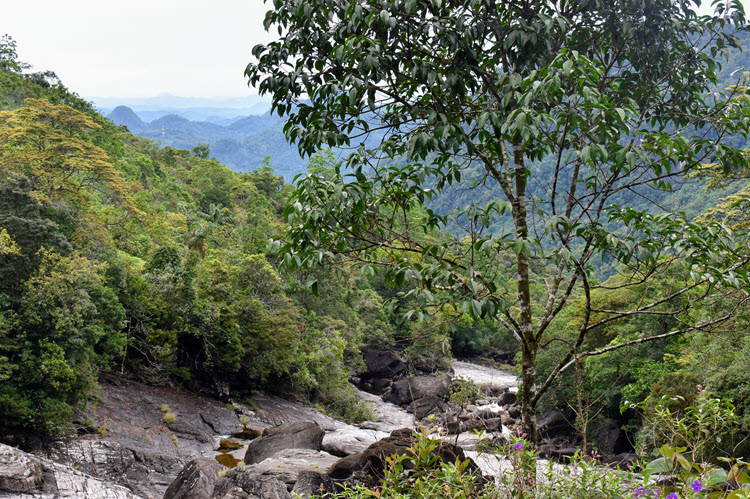Tea Biz traveled to Sri Lanka in May to the foot of 7,359-foot Adam’s Peak, known locally as Sri Pada (the Budda’s Footprint), a conical sacred mountain ideally suited to tea. Forest Hill Tea founder Buddika Dissanyaka narrates a hike he is leading to a forest of 900 tea trees growing wild on an estate abandoned 140 years ago.
- Caption: Forest Hill founder Buddika Dissanyaka at the edge of Sri Lankan tea forest.

An Abandoned Estate Transforms into a Tea Forest
By Dan Bolton
Millions of tea trees, first Introduced in 1867, can be found along the 268-mile length of Sri Lanka, a tropical paradise of tea estates that employ 1.5 million people today. The trees at Warnagala Tea Estate, established in 1890 by Scottish planters, today rise 40 to 50 feet into the rainforest canopy on the slopes of the sacred Sri Pada Mountain range. Pluckers climb into the trees to retrieve green leaves for tea making.
We’ve traveled a long winding road and crossed narrow bridges over fast-moving streams to reach a forest of tea trees 2,900 feet above Sri Lanka’s shores. Joining us to talk about opportunities in specialty tea is Buddika Dissanyaka, one of many smallholders that have energized Sri Lanka’s tea sector. This new generation of rural entrepreneurs produces much of the tea grown in Sri Lanka, one of the world’s top tea-producing countries.
Dan Bolton: The tea forest is quite remarkable, Buddika. Will you share your story with our readers?
Buddika Dissanyaka: Thanks for coming all this way to hear from us.
I’m a professional planter. After schooling, I joined the planting sector as a junior assistant superintendent, and I continued my career for 15-16 years to become one of the youngest superintendents in Sri Lanka.
And then, I thought of starting something extraordinary. I have a good knowledge of tea and did a lot of research into what I might do. I figured out that there is a potential for making artisanal handcrafted teas. So here we are, speaking, just below the tea forest.
While attending school in Kandy, I used to go down here with my friend to hike at this place. I noticed that it had very big tea trees growing in the forest. So I thought to start handcrafting artisanal wild tea for the first time in the history of Sri Lanka from this source.
Since then, we have officially registered under the Sri Lanka tea board to start a micro tea factory. And now, we are proud to say that we are handcrafting artisanal tea and circulating it around the world. And we won some gold medals. We showcase that Sri Lanka can actually produce very good quality teas compared to the other countries that make very high-quality tea.

Dan: Will you describe the pristine waterfalls and steep hillsides and explain how the dense forest that surrounds us, with its diversity of wildlife, animal life, and plant life, improves the tea?
Buddika: This estate was originally planted by Scottish planters. They originally brought seeds from Assam, India, and Yunnan Province in China. So we have both varieties growing in the forest. One is Camelia sinensis, and the other is Camelia sinensis assamica. About 140 years back, the founders just abandoned it. The forest has reclaimed the estate over a century without human touch.




“The forest has reclaimed the estate over a century without human touch.”
– Buddika Dissanyaka
During our century, the tea estate developed a thick biodiversity where animals are roaming, different species are growing, and spices are growing. So it gives a different character to our wild tea. The root structures are such that the taproot has gone down and down and down where it absorbs top-quality minerals for its leaves. We focus on very high-quality leaves to craft our teas. So our tea has very different characteristics.
Dan: So this is a tea blended by nature. The two species often don’t grow side by side, but because of the unique nature and microclimates in Sri Lanka, we can see mature teas joined together to create a bio-fauna. It’s a situation in which the teas live together in harmony.
Buddika: Yeah, it’s actually very unique.
Dan: We proceed two kilometers, climbing a wash that serves as a service road until we reach the edge of the tea forest.
Buddika: Now we are in the forest.
This is Camellia sinensis, the assamica type of tea tree. These are small tea trees. So we have a lot of big tea trees. We have plenty of assamica, but we have lesser amounts of Camellia sinensis sinensis. So, these trees are living in harmony with the forest. You can see this one is a Camellia Sinensis sinensis. We make a lot of green teas from this variety, which is a very subtle, smooth tea.
Dan: In this area, there are wild-grown spices, right?
We know many of the species growing in the forest are original plants. So, we know what is wild pepper, wild cardamom, wild clove, and wild cinnamon. We also saw stores offering lots of artisanal natural spice blends. So, we began sourcing our spices in a very sustainable manner. We don’t disturb the diversity in the forest. We harvest only small quantities in the proper season and return to our factory and do our blending. And that is how we preserve this nature.
Dan: When we returned to the small two-story factory in Kuruwita, I asked Buddika to tell us more about his technique of hand-processing these teas in small batches.
Buddika: We craft only wild forest-grown tea without damaging the environment and are becoming an example to others. We can work within the forest without destroying it. All our artisans are very skilled, and we always guide them to develop their skills, as we are so concerned about the quality. We are making a small profit in our retail business, so we would like to expand our retail business since the profit margins go to all the stakeholders including artisans, farmers, and the local community.
Dan: Will you share details about how you market your teas overseas?
Buddika: We can ship our teas worldwide by DHL, and EMS customers can reach us through our Facebook and INSTAGRAM.
See: Wild Forest Grown Ceylon Tea
Link to share this post with your colleagues
Signup to receive Tea Biz weekly newsletter in your inbox.



